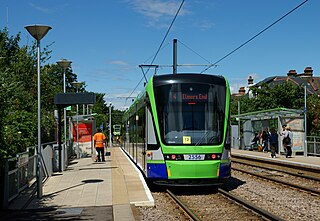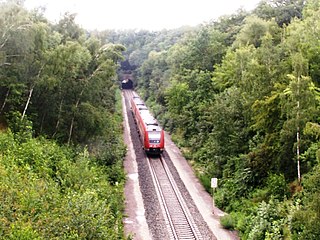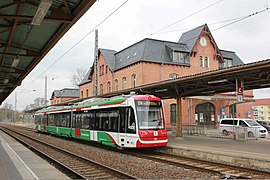
A tram-train is a type of light rail vehicle that both meets the standards of a light rail system, and also national mainline standards. Tramcars are adapted to be capable of running on streets like an urban tramway but also be permitted operation alongside mainline trains. This allows services that can utilise both existing urban light rail systems and mainline railway networks and stations. It combines the urban accessibility of a tram or light rail with a mainline train's greater speed in the suburbs.

The Karlsruhe model is a tram-train system which consists of tram/light rail trains and commuter/regional rail trains running on the same set of tracks, generally between or outside of urban areas. It was initially developed and implemented in the city of Karlsruhe, Germany, by the local transit authority, Karlsruher Verkehrsverbund (KVV).

Stadtbahn is a German word referring to various types of urban rail transport. One type of transport originated in the 19th century, firstly in Berlin and followed by Vienna, where rail routes were created that could be used independently from other traffic.

Stadler Rail is a Swiss manufacturer of railway rolling stock, with an original emphasis on regional train multiple units and trams, but moving also into underground, high speed, intercity and sleeper trains. It is also producing niche products, such as being one of the last European manufacturers of rack railway rolling stock. Stadler Rail is headquartered at its place of origin in Bussnang, Switzerland. Stadler Rail employed 13,900 employees by 2023.
Die Länderbahn GmbH (DLB), formerly Vogtlandbahn GmbH, is a German rail transport company based in Viechtach, operating transport services originally only in the Vogtland, but now also on a regional basis. Die Länderbahn is a subsidiary of Regentalbahn AG, which is owned by Ferrovie dello Stato subsidiary Netinera. The term vogtlandbahn remains in use as a trademark of Die Länderbahn in Vogtland.

Chemnitz Hauptbahnhof is the main railway station in Chemnitz in Germany.

The Stadler Variobahn is a German-designed model of articulated low-floor tram and light rail vehicle. Since its introduction in 1993, the Variobahn has been manufactured variously by ABB, Adtranz, Bombardier Transportation, and since 2001 by Stadler Rail. As of 2009, 254 trams have been ordered, with an additional 110 on option. A unit costs about €2.5 million.

The Chemnitz–Adorf railway is a branch line in Saxony, Germany that was built and operated by the Chemnitz-Aue-Adorfer Eisenbahn-Gesellschaft (CAAE). The 115 km long line originally ran from Chemnitz in a southwesterly direction along the valley of the River Zwönitz to Aue. From Aue the line ran along the Zwickauer Mulde to Muldenberg and up to Schöneck and through Markneukirchen to Adorf in Vogtland.
Mittelsachsen is a district (Kreis) in the Free State of Saxony, Germany.
The Stadler Regio-Shuttle RS1 is the first widely used, new-generation, diesel railcar in Germany and Czech Republic for local railway services. Its most characteristic feature is the trapezium-shaped window frames. The Regio-Shuttle is classified by the Deutsche Bahn as Class 650, by the České Dráhy as Class 840 or Class 841, however numerous private railways have their own Regio-Shuttles.

The Interregio-Express (IRE) is a local public transport railway service operated by the Deutsche Bahn which is only available in the German states of Baden-Württemberg, Bavaria, Saxony, Saxony-Anhalt and Berlin as well as in Switzerland. The IRE service was first introduced in the 2001 summer timetable, due to the increasing abolition of Interregio routes by DB's long-distance division. As a result, several German states ordered InterRegioExpress trains on the routes affected. In addition IRE trains were also introduced on routes that had not previously had an Interregio service.
The Dresden–Werdau railway is an electrified, double-track main line in the German state of Saxony. It runs from Dresden via Freiberg, Chemnitz and Zwickau to Werdau wye, where it joins the Leipzig-Hof railway.

The Mid-Germany Railway is a rail link between German states of Thuringia and Saxony. The central element of this link connects Chemnitz and Glauchau in the east via Gera and Jena to Weimar in the west. It includes the Dresden–Werdau line, the Glauchau–Gößnitz line, the Gera–Gößnitz line and the Weimar–Gera line.

The Neukieritzsch–Chemnitz railway is a line in the German state of Saxony. It branches in Neukieritzsch from the Leipzig–Hof railway and runs via Borna and Geithain to Chemnitz Main station. It is part of a long-distance connection between Leipzig and Chemnitz. The route is electrified between Neukieritzsch and Geithain.
The Roßwein–Niederwiesa railway is a branch line in the German state of Saxony. It runs from Roßwein through the Striegis valley to Hainichen and on to Frankenberg and Niederwiesa, where the line ends at a junction with the Dresden–Werdau railway. Since 2004, only the 16.8 km long section between Niederwiesa and Hainichen is still operating.

The British Rail Class 399 Citylink is a type of rail vehicle built by Vossloh on its Citylink platform for operation by Sheffield Supertram. Primarily a low-floor tram, it is also capable of being used on the National Rail network; the Class 399 is the first such tram-train to see operational use in the United Kingdom.

The Stadler Citylink is a series of tram-trains manufactured by Stadler Rail at its Valencia factory since 2011. The design was introduced by Vossloh España before their takeover by Stadler Rail in 2015. They are currently used in Germany, Hungary, Mexico, Spain and the United Kingdom, with more on order in Austria.

Meerane station is a railway station on the Glauchau–Gößnitz railway. Meerane station is the only station in the town of Meerane in the German state of Saxony. The station is now served by Regionalbahn and Regional-Express services on the Mid-Germany Connection (Mitte-Deutschland-Verbindung). Freight transport facilities no longer exist.

Süd-Thüringen-Bahn GmbH (STB) is a public, non-state-owned railway company founded on 10 December 1999. The shareholders are Erfurter Bahn GmbH (EB) and Hessische Landesbahn GmbH (HLB), each with a 50 percent stake. The company is based at Erfurter Bahn in Erfurt, Thuringia. The operating location and operational management are located in Meiningen, Thuringia.

Regio Infra Service Sachsen GmbH (RISS) is a railway infrastructure manager and a railway company (EVU) founded in 2001. The shareholders are Chemnitzer Verkehrs AG (CVAG) and RP-Eisenbahn GmbH (RPE). The company is based in Chemnitz, Saxony, Germany.





















